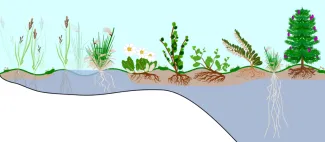Arctic vegetation classes miss variation in rooting depth distribution and rhizosphere priming-induced carbon emmissions.
The amount and depth distribution of roots throughout the highly organic soils of northern biomes are predicted to have significant effects on soil carbon emissions given the large amount of root biomass and its intimate contact with the soil. However, the question remains about how to predict belowground vegetation characteristics across the remote northern latitudes. A recent paper by Blume-Werry et al. (2023) found that tundra rooting depth distribution cannot be inferred from commonly used aboveground vegetation mapping units, complicating the ability of modelers to make inferences about belowground dynamics from more easily measured aboveground vegetative cover across the remote tundra biome. In an associated commentary, we used the foundation of vegetation treatment in terrestrial biosphere models—plant functional types (PFTs)—to consider how empiricists and modelers might infer and thus better understand the unique belowground characteristics of vegetation growing in highly organic, high-latitude soils. We suggest a guide for a ‘root functional type’ framework in terrestrial biosphere models that emphasizes the unique belowground characteristics of high-latitude plants associated with rooting depth distributions, mycorrhizal type, leaf longevity, belowground allocation, aerenchyma formation, and symbiosis with nitrogen-fixing bacteria. For example, in high-latitude systems, roots are often constrained by permafrost and waterlogged conditions to a thin ‘active layer’ of soil that thaws seasonally. In turn, tundra plants allocate a large proportion of their biomass belowground to escape harsh environmental conditions aboveground.
Citation: Weber SE, Iversen CM. 2023 How deep should we go to understand roots at the top of the world? New Phytologist 240: 457–460 (A commentary on Blume-Werry et al. (2023), 240: 502–514). https://doi.org/10.1111/nph.19220.
Contact and email address: Sören Weber (weberse@ornl.gov)
Changes in active layer thickness (light brown, underlain by permanently frozen soil, white) and water table height (blue) from graminoid to wetland tundra and then from prostrate- and erect-shrub tundra toward the boreal forest (from Northern tundra to more Southerly boreal forest as you move from the left to right). Roots of many PFTs growing in highly organic soils are limited in their depth distribution by permafrost and high-water tables (except graminoids with aerenchymous roots).


